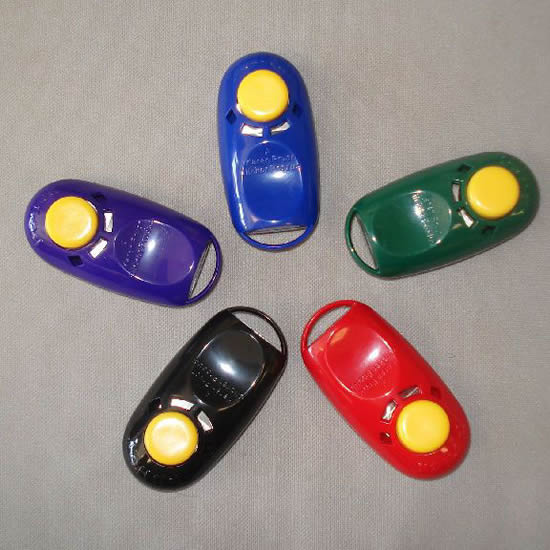Clicker training is a fast, simple way to communicate clearly to your dog. Every click says “good dog!” and every click is a promise of reward.
Many people seem reluctant to embark on clicker training their dogs. We get it. The timing and mechanics take a while to smooth out. But it’s worth it. As fluency increases, it gives you more flexibility in training your dog. Every “click” is a promise to your dog. It’s an affirmation dogs love (you’re doing good!) and a pledge that their good work will be rewarded.
Everybody’s clumsy at first
Whether you hold the clicker in your hand or have it on a wrist strap doesn’t matter. There are times it’s not where you need it to be. Or you drop it, or it twirled around your arm and isn’t where it should be.
It doesn’t matter. Your dog doesn’t care and won’t tell anybody that you may have messed up. Your training class teacher has been there, done that. It’s worth sticking with it to be able to use this great training tool.
Nobody has enough hands to manipulate leash, clicker, and treats at the same time. The whole concept of the clicker is its use as a bridge between the behavior and the reward. It lets your dog know “Yes! You’re doing it right!”
Clicker familiarization
Dogs catch on really quickly to clicker training. Most dogs get it after a single session: Have 10 treats in a bowl. Click and give your dog a treat. 10 times. That’s it. You’re on your way to having your dog love the sound of the clicker.

At first you absolutely have to give your dog a reward every single time you click. Even if you click by accident. Even if the clicker hit the ground and clicked. Remember that dogs don’t understand “sometimes” or “maybe.” The value of the reward transfers to the sound of the click. Done consistently, it will always make your dog happy. If you don’t follow through, you diminish the value and your dog won’t care about the click.
Better than “Yes!”
There are a couple of reasons that a vocal marker like “Yes!” doesn’t have the same impact as the clicker. It takes longer to talk than click. Once you become used to using the clicker, it’s almost automatic; you see something you like and you click. If you use a vocal, you have to think about it. It has to process through your brain rather than going right to your reflexes.
The clicker is also a sharper sound, more distinguishable in a noisy or distracting environment. Even in a clicker training class, the dogs can tell when it’s “their” clicker that made the sound. We’re not sure how they know, when everybody has the same equipment, but they do.
Give it some time
If you’ve dismissed the idea of clicker dog training, or at some point decided it wasn’t for you, give it another try. You certainly don’t have to use it all the time, or for every behavior. But there are some games where it’s priceless. It gives you the freedom to lock your eyes on your dog and mark the action you want precisely. When Hope’s French Bulldog Torque is playing his “Bowling” game, he knocks down all 10 pins, hears a click as each one goes down, and then runs back for his reward. It started with one pin, one knock-down, and one click. Games can grow click by click.
